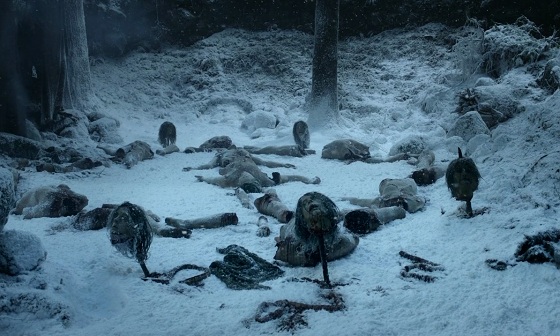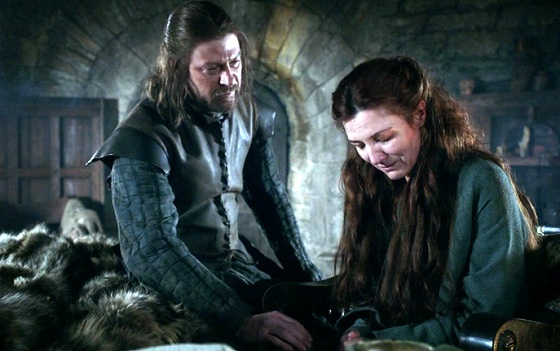How does HBO’s Game of Thrones compare to the continuity of George R.R. Martin’s A Song of Ice and Fire? I’ll be assessing the biggest deviations the TV series has made on an episode-by-episode basis, and speculating on what effects the changes could have on future storylines. For the sake of ease, the altered appearances of characters (of which there are numerous), will not be included in any of my breakdowns.
It goes without saying that these articles will contain spoilers for Game of Thrones, but be wary that various events from A Song of Ice and Fire, which have yet to transpire in the TV series at the time of writing, will also be addressed on occasion. I will use a spoiler tag to ward anyone who doesn’t wish to have any of these moments ruined for them, which will be bold and capitalised, so there’s no excuse for missing it!
1. The Prologue

TV: The episode opens with Will, Gared, and Waymar Royce travelling out beyond the wall on a ranging, only for Will to happen across the slaughtered remains of a Wildling camp during one of his scouts ahead. Will notifies his two brothers of what he’s seen, but upon leading them back to the location, the deceased and all traces of them have vanished. A White Walker then appears as they are investigating and immediately cuts down the deriding Waymar Royce, before engaging pursuit and eventually beheading Gared as well. We later learn, after the title sequence, that Will fled back to the Wall and carried on south, until ultimately having his head lopped off by Ned Stark for the treasonous crime of desertion.
BOOK: Apart from the ranging having been underway for some time before the book begins, the biggest difference is the manner of Waymar Royce’s death, and the fact that it is Gared who survives the ordeal, not Will.
As the Others (which is what non-Wildlings call them) begin to rise from the winter snows, Will climbs up into one of the trees, whilst Royce admirably fends off an Other from below. He is bested in the end, predominantly due to the inferiority of his ordinary steel sword, but it’s clearly inferred that he was a very capable fighter, which is an emphasis absent from the swift end he meets in the TV series. Will then unwittingly descends from his tree to be greeted by Royce, reawakened as a Wight, who subsequently strangles Will to death.
The reason Gared eventually escaping the carnage unscathed is important, is because he was a loyal veteran of the Night’s Watch, so his absconsion and urges that the dead were rising carried infinitely more weight than the relatively unseasoned Will’s would. Of course, that still didn’t prevent Ned executing him, but it meant that his words weighed quite heavily on his sentencer, rather than simply being disregarded as the desperate ravings of a craven.
2. Arya the Archer

TV: Early on during “Winter is Coming”, we see Bran practicing his bowmanship under the watchful eyes of his father, mother, brother, and half, bastard brother. We also briefly glimpse Arya enduring her Septa’s needlework class, before she ambushes Bran’s training, and upstages him. Additionally, we see Arya thriving under the mentorship of Anguy, the resident archer of the Brotherhood without Banners, in Season 3 — once again displaying how able she is as a burgeoning archer.
BOOK: Arya never demonstrates such proficiency as an archer in the books, because up until even the latest instalment, A Dance with Dragons, she’s never had the fortune to practice with the bow and arrow. She always uses daggers or swords, and she’s been shown a number of times to indulge in slightly overzealous butchery with her blades (e.g. murdering one of the guards at Harrenhal with obvious enthuse, a moment that bears patent similarities to TV Arya’s assassination of the Frey soldier mocking her dead mother and brother in the Season 3 finale, “Mhysa”).
3. The Timeline

TV: Game of Thrones begins seventeen years after King Robert’s uprising. Robb and Jon are 17 years of age; Bran is 10, Rickon 6, Sansa 13, and Arya 11. Similarly, the ages of the Lannister youths are upscaled to coincide; Joffrey is 16, Myrcella is 12, and Tommen 10. Targaryen Princess, Daenerys, is also older, now 16 years old.
BOOK: The events of Martin’s first novel, A Game of Thrones, initiate fourteen years after Robert’s rebellion, making the respective ages of all the youngsters around 3-4 years lesser than in the television series.
It’s understandable why the TV show runners opted to increase the timescale, as moments that occur in the books would have been deemed unacceptable for the TV if the participating characters’ ages had remained the same — for instance, the initially unconsenting consummation on the night of Daenerys’ marriage to Khal Drogo is all the more unpleasant to abide in the book, considering her barely adolescent age of 13. But it provides crucial emphasis on the depravity that governs Martin’s world. And Robb’s kingship being thrust upon him at the age of 15, rather than the corresponding 18 of the TV series, more substantially absolves the naivety of some of his leadership decisions. So, whilst the increased passing of time is mostly inconsequential, it does somewhat nullify certain elements that are more heavily enforced in the books.
4. Where are the Snows of Winterfell?

This is mostly included in jest, but in the books, Winterfell is described as being hemmed by mounds of snow all around its outer walls (not to mention the densely wooded landscape). Whereas, in the TV series, Winterfell is shown to be surrounded by rolling hills of green grass, with not a speck of snow in sight. Considering that Winterfell centres the northern region of Westeros, it makes sense that it should be subject to the wintry weather it is in the books, rather than the mild, autumnal climate we see in the TV series.
5. Lysa’s Letter of Warning

TV: Catelyn’s sister, Lysa, sends a raven from the Eyrie, to which she has fled from King’s Landing after Jon Arryn’s death, warning Cat that the Lannisters are conspiring to usurp Robert’s throne, and were responsible for the death of her husband.
WARNING: BOOK SPOILERS FOLLOW
BOOK: Lysa goes to great efforts to safeguard her accusatory message from prying eyes; coding it, concealing it in a box with a false bottom, and employing a messenger who leaves it unseen in Maester Luwin’s chambers. The extensive measures Lysa goes to are indicative of her intense paranoia (and so unlikely to be deemed suspect by Cat or Ned), but her insouciance about concealing her letter’s contents in the TV series isn’t, and could perhaps be an early allusion to her revelation in A Feast for Crows that it was in fact she who poisoned Jon Arryn, and that her warning was all a part of the deception.
6. Cat Protests to Ned’s Royal Appointment

TV: Ned grudgingly accepts the fact that, by his own noble custom, he is honour-bound to serve as the King’s Hand, per King Robert’s request. Catelyn is devastated at the prospect of Ned leaving at Robert’s behest again, as he did during his friend’s rebellion, chastising her husband’s nobility as an excusing falsehood characteristic of all men.
BOOK: It’s Ned that wishes to remain in Winterfell with his family, and Cat that urges him to help his King and friend in need. Martin emphasises the sheer level of contempt that Ned harbours for the southron environment of King’s landing and its scheming hierarchy, through the character’s Starkly (pun intended) uncharacteristic desire to forego a call of honour like this, and at the same time, the resolute strength of the Lady Catelyn, who would sooner see her husband leave her midst and be by Robert’s side to protect him, than sacrifice his all important honour.
7. Jaime Lannister is a Lefty?

Again, this isn’t an entirely serious inclusion, but an interesting difference between what’s depicted in the TV series and Martin’s books. In A Song of Ice and Fire, it’s specified that Jaime pushes Bran Stark with his right hand; his sword hand. It is with the later severance of that hand that Jaime begins to undergo his drastic change of character. His right hand represented everything that was inherently bad about him; it was a metaphor for his immorality (as he emphasises to Brienne: “I was that hand.”). So, as trivial as it might first seem, it was symbolically crucial that his attempted murder of Bran was done with his right hand, and not his left.
I really enjoyed reading this, thank you.
Cheers for the kind comment and following my blog. I’m glad you enjoyed it. There will be plenty more coming!
That’s great! Thank you :). Now I’m following ill look forward to it :).